PRE2018 3 Group2
0LAUK0 - 2018/2019 - Q3 - group 2
Group members
| Name | Student ID |
|---|---|
| Koen Botermans | 0904507 |
| Ruben Hendrix | 1236095 |
| Jakob Limpens | 1019496 |
| Iza Linders | 0945517 |
| Noor van Opstal | 0956340 |
Introduction
Planning
The tasks and milestones (both the ones already achieved and those on our to do lists) of this group are elaborated on in the Gannt Chart accessed by the following link: Gannt Chart
Problem Statement
We live in an ageing society, the number of elderly people is ever increasing [1]. As a consequence, pressure on caregivers is rising. The research area on possibilities to alleviate this pressure by means of a robotic platform is increasing in size. Emotional comfort tends to be vital in medical environments, and such a robotic platform needs to conform to this aspect of elderly care [2]. For our project, we want to zoom in on a particular part of many modern robots, the part having as primary task the portrayal of emotional information: screen-based faces. During the eight weeks of this project, we will set up a research plan, carry out test with the target users – seniors – and attempt to design and validate a screen-based robotic face. Since our group is a multidisciplinary team this problem will be approached from both a technical perspective and a user centered perspective.
Initial ideas
Objectives
To get a better overview of what needs to be done to complete the project, we set ourselves a couple objectives:
System objectives:
- The system should be able to express emotions in a manner that is natural, non-ambiguous and clear.
- The system should behave like a human, without entering the uncanny valley.
Research objectives:
- We want to understand how elderly react to different facial emotions/designs expressed by a robot.
- We want to optimize the way that robots show emotions to elderly-users.
State of the Art
Different themes related to our project can be identified. They are listed here, together with the relevant papers that provide the stated information.
Robot emotion expression
Different papers provide an insight into the existing technology in the field of recognizing human emotion in HCI research.[3] Article 1 provides a discussion of existing literature on social robots paired with care for elderly suffering from dementia. It also discusses what contributions and cautions are bound to the use of these assistive robotic agents, and provied literature related to care of elderly with dementia.[4] Article 2 places its focus on the more general user, and contains a study about the effect of a robot's expressions and physical appearance on the perception of said robot, by the user.[5] Article 3 and Article 4 present a description of the development, testing and evaluation of a robotic system, and a framework for emotion interaction for service robots, respectively. Article 3 focuses on the development of EDDIE, a flexible low-cost emotion-display with 23 degrees of freedom for expressing realistic emotions through a humanoid face, while Article 4 presents a framework for recoginition, analysing and generation of emotion based on touch, voice and dialogue.[6][7] The results of a different project, KOBIAN, are described in Article 5. Here, different ways of expressing emotions through the entire body of the robot are tested and evaluated.[8]
Emotion recognition
In Article 6, titled "Affective computing for HCI", multiple broad areas related to HCI are adressed, discussing recent and ongoing work at the MIT Media Lab. Affective computing aims to reduce user frustration during interaction. It enables machines to recognize meaningful patterns of such expression, and explains different types of communication (parallel vs. non-parallel).[9] Article 7 consists of a large elaboration on emotion, mood, effects of affect which yields performance and memory, along with its causes and measurements. There is an interaction of affective design and HCI.[10] A study on emotion-specific autonomic nervous system activity in elderly people was done in Article 8. The elderly taking part followed muscle-by-muscle instructions for constructing facial proto-types of emotional expressions and re-lived past emotional experiences.[11] Reporting on two studies, Article 9 shows how elderly have difficulty differentiating anger and sadness, when shown faces. The two studies provide methods for measuring the ability of emotion recognition in humans.[12] Lastly, a definition of several emotions and their relation to physical responses is needed (breathing, facial expressions, body language, etc.). Article 10 describes how a computer can track and analyse a face to compute the emotion the subject is showing. Useful as an insight in how input data can be gathered, analysed and used for the purpose of mimicking or mirroring by a robot.[13]
Assistive technology for elderly
This category focusses mostly on robotic care for elderly living at home. Articles such as article 15 [14] and article 11 [15] explore the effect of robots to the social, psychological and physiological levels, providing a base for knowing what types of results certain actions yield.
Article 14 [16] explores six ethical issues related to deploying robots for elderly care, article 13 [17] provides more knowledge when it compares children, elderly and robots and their roles in relationships with humans.
Article 12 [18] looks at the available technologies for tracking elderly at home, keeping them safe and alerting others when needed.
Dementia and Alzheimer's
Closely related to elderly are the diseases Dementia and Alzheimer’s. These diseases affect the brain of a patient, making them forgetful or unable to complete tasks in their day-to-day life without help. Article 16 [19] elaborates on this and explains the impacts and a possible framework to counter these diseases is proposed. Article 17 [20] discusses whether an entertainment robot is useful to be deployed in care for elderly with dementia.
Measuring tools
Here, papers are collected that provide aid for designing a robotic system, article 18 [21] discusses some of the difficulties in measuring affection in Human Computer Interaction (HCI). For designing a system that is capable of expressing emotion, article 19[22] and article 20 [23] show recent developments when designing a ‘face’ or whole body to express emotion to a user.
Miscellaneous
In the study of emotions, models are often useful. Article 21 elaborates on social aspects of emotions, together with the implementation in human-computer interaction. A model is tested and accordingly a system is designed with the goal of providing a means of affective input (for example: emoticons). [24]
Article 22 describes emotional comfort was researched in patients that found themselves in a therapeutic state. It provides an understanding of the role of personal control in recovery and aspects of the hospital environment that impact hospitalized patients’ feelings of personal control.[25]
A more medical approach is taken in Article 23: evidence is provided for altered functional responses in brain regions subserving emotional behaviour in elderly subjects, during the perceptual processing of angry and fearful facial expressions, compared to youngsters.[26]
Statistics about the greying of global population provide insight in challenges paired with this greying. Article 24 is a collection of evidence for the greying of the wordl's population, with causes and consequences. It states three challenges.[27] Article 25 indicates the importance of a healthy community to the efficiency and economic growth of said community. It points out the goals of improving the healthcare system and how these improvements can be made.[28]
Characterizing the Design Space of Rendered Robot Faces[29]
A study on the design space of robots with a digital (screen-based) face. Summary can be found here.
Project setup
Approach
Milestones
Deliverables
At the end of this project period, these are the things we want to have completed to present:
- This wiki page
- A study report
- A prototype
User Research
Introduction
When designing a robot face, the designer is confronted with a wide range of possible design choices. Previous studies have attempted, and to some degree succeeded, in analyzing this design space. One study in particular, “Characterizing the Design Space of Rendered Robot Faces”, takes non-fictional screen-based designs, and conducts a survey on the influence of the different aspects characterizing these faces. Based on the survey results, they then create a baseline face and vary different details. A second survey is conducted on the influence of these variations. However, this study focuses on the general appearance of robot faces, where we want to research the portrayal of emotions. We will draw inspiration from the methods used by our colleagues, and further investigate the design choices one could or should make, when designing a screen-based robot face. Below we first describe in the methods section the structure of the interviews, thereafter we represent the results, derive a conclusion and give an discuss further research possibilities.
Method
This section elaborates on the structure of the interviews conducted. These interviews consisted out of 3 parts; the introduction questions, test 1 and test 2. Below all these three parts are described:
- The introduction questions, the purpose of this part was putting the mindset of the interviewees on the subject of robots. This can be done with the questions in document
- Test 1, to determine which emotions are associated with certain eye shapes (relatively speaking) one can ask the interviewees to sort faces (with different eye shapes) based on the their first response for certain emotions. The emotions tested where: Friendliness; Anger; Sadness; Joy; Surprise; Dislike; Fear. Since every emotion resulted in a sorting we noted for every emotion/face combination there relative response, where a five correspond to “the most” and a one corresponds to “the least”. The faces used are given in Figure 1.
- Test 2, to test the emotions associated with certain eye colors one can use the same method as with test 1, thus asking the interviewee to sort faces on their initial response. The faces used for test 2 are given in figure 2.
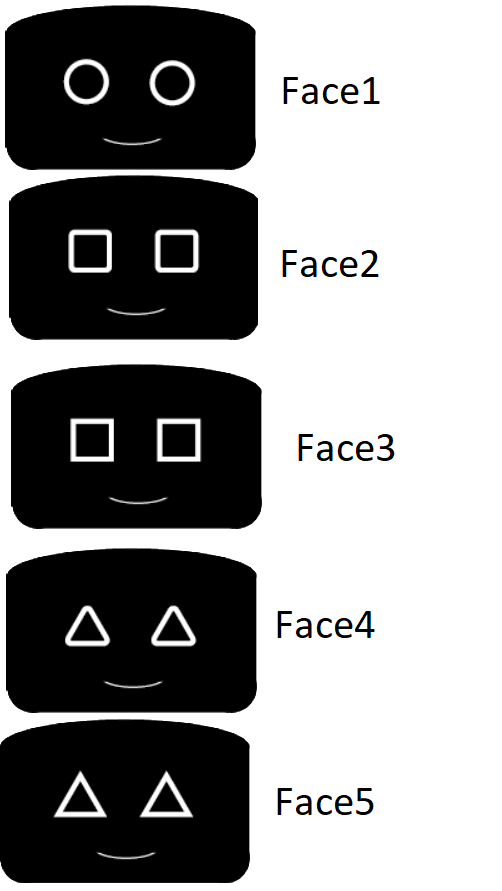
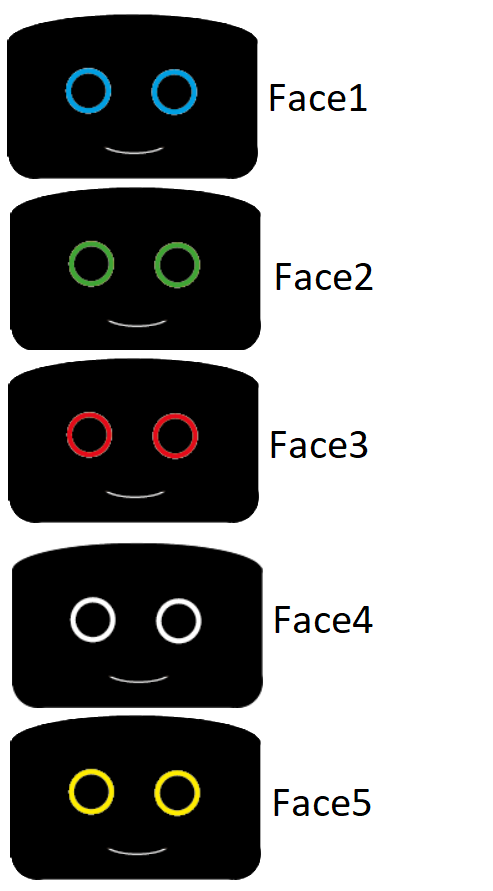
Interview plan ( First try, before Feedback)
Interview Guide
INLEIDING - vragen bedoeld om de mensen vast in het thema te laten denken.
- Zou u een robot kunnen vertrouwen? Wat heeft u nodig om een robot te kunnen vertrouwen?
- Wat verwacht u van een robot?
- Welke positieve/ negatieve ervaringen heeft u al met robots? Wat zou u graag anders zien aan robots?
- Zou u gebruik willen maken van een robot? Waarom wel/niet?
- Hoe zou je willen dat het gezicht van een robot eruit ziet?
- Wat voor materiaal zou je willen hebben bij een robot?
ROBOT IN DE ZORG- VRAGEN
- Wat is, voor u, het belangrijkste aan het ontvangen van zorg?
- Wat zou u er van vinden, deze zorg van robots te ontvangen?
- Welke taken denkt u dat een robot kan uitvoeren in de context van (thuis)zorg?
- Hoe belangrijk vindt u het, dat contact met uw verzorger emotioneel is?
- Welke eigenschappen moet een robot hebben om betrouwbaar te zijn/over te komen?* Wil je liever dat een robot zijn emotie prettig/comfortabel of duidelijk is?
TESTPLAN
Test 1
- Select various shapes (squares, triangles, circles), and variations of these shapes (tall, broad, small, large, etc.)
- Show these to people and ask them to rate them on likert scale of emotions
- Use 6 basic emotions: happiness, anger, sadness, surprise, disgust, fear
- Sidenote: movement/dynamic shapes not included in this test, while the transitions between shapes may affect the implied emotion.
- Sidenote: no knowledge is gained about the expected, context-dependent reaction of an emotional interface (i.e. nuance in mirroring emotion; laughing when expected to be angry; etc.)
- Alle vragen doornemen met de ouderen, aan het einde van de vragenlijst, de vragen doornemen om meer inzichten te kunnen krijgen.
- Welke van de vormen zou u het liefst in een gezicht zien?
- Welke van de vormen zou u het liefst zien als ogen voor een robot?
- Welke van de vormen zou u het liefst zien als neus voor een robot?
- Welke van de vormen zou u het liefst zien als mond voor een robot?
Doel van deze test is erachter komen welke vormen het meest toepasselijk zijn voor het gebruiken als communicatiemiddel voor emoties.
Test 2
- Select various robots displaying emotions from visual media.
- Rank robots on the amount of humanity displayed
- Ask questions about the various pictures:
- Which is preferred for tasks inside their personal space?
- What emotion expresses the emotion angry/happy/etc. the best/the most clear?
- Welke robot vond u het vrolijkste (met alle emoties)?
- For various tasks, which robot would you pick to do this task?
- Stofzuigen
- Koffie zetten
- Medicijnen geven
- Eten geven/koken
- Hulp met douchen
- Activiteiten: schilderen, etc.
Side note: we are aware of the fact that there may be some bias met de characters van de robots.
Doel van deze test is een richtlijn vinden om te zien welke trekken van een robot, daarbij ook welke mate van menselijkheid gewenst is voor een robot die ouderen zouden gebruiken in hun eigen omgeving.
Interview guide
Via the link below you can see the interview guide we are using, including the pictures and scales that we use for the two tests.
https://drive.google.com/open?id=1E91jO9-nM1NU0apAUHHymIyyJo98OSrf
Interview plan ( Second try, after Feedback)
https://drive.google.com/open?id=1DhAuVQ5AHjHgi6Yt51g0OR6pSJITHXHh
Results
Thematic Analysis
The analysis and results of the thematic analysis can be found in this folder on the drive: https://drive.google.com/open?id=1KeOm4rlhoSu8TOCgDGDPvSoPuMc2ijd1 This folder includes:
- The recorded interviews - The informed consent forms - The transcribed and coded interviews - The determined codes and themes - The relational scheme of themes - The results section - The discussion section
Results
To obtain and visualize results, both STATA and the scikit-learn where used. The results for tests 1 and 2 are given in figure 3 and figure 4 respectively. In these figures a score of 5 means that the face is “the most” friendly/angry/sad of all the faces shown to the interviewee. And a score of 1 means “the least”. The excel file with the raw results can be found in the following link: Raw results
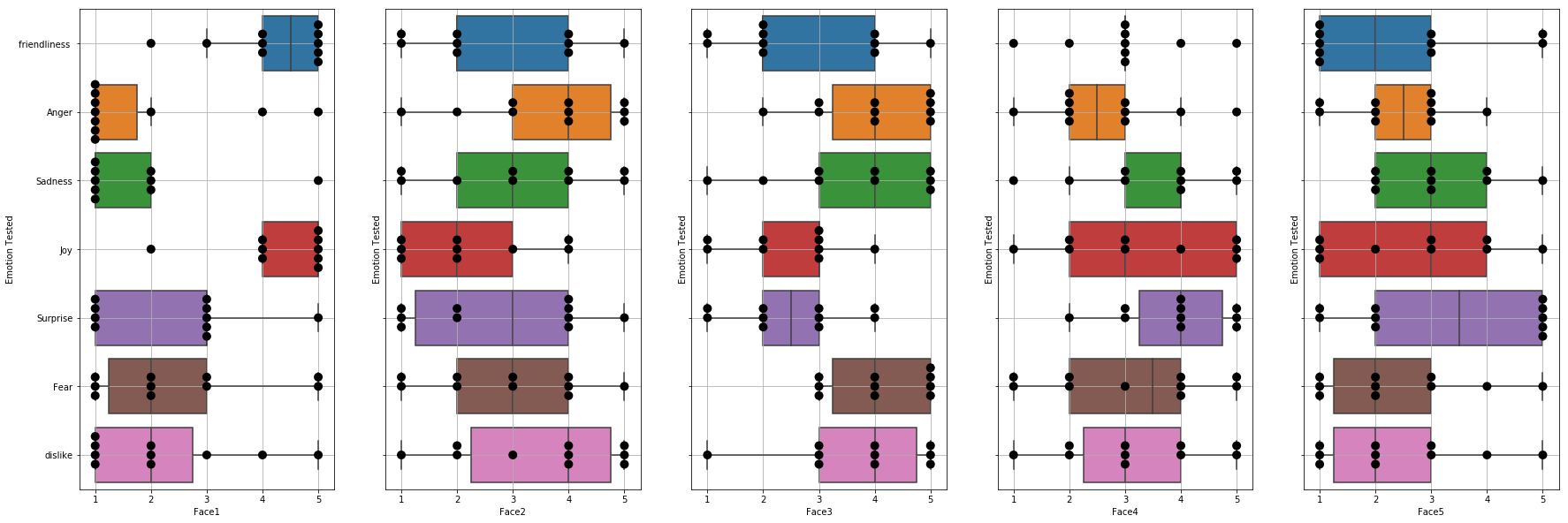
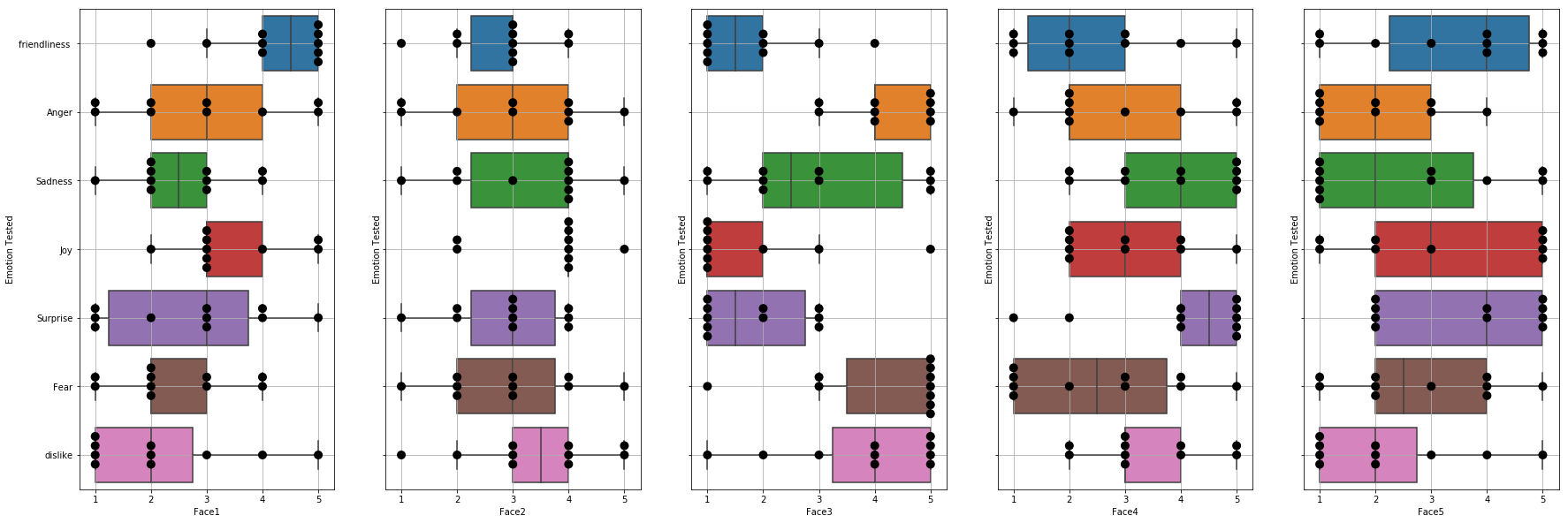
Normality
With STATA the normality was checked, for each combination of face and emotion. The normality was fine for all faces and emotions except for;
- face 5, the normality was rejected for the emotion of surprise;
- face 8 for the emotions joy and fear.
Since the normality was pretty close to being supported we decided to keep face 5 and face 8 in the dataset.
Regression
After checking the normality we ran regressions on all emotions. The used emotions are friendliness, anger, sadness, joy, surprise, dislike and fear. The used faces can be found in the method. The results of these regressions will be discussed in this section. In the explanations down below, the effect of the coefficient will be mentioned. To elaborate this; having a coefficient of +3 means that, if the unit of the emotion increases by 1, the unit of the variable with a coefficient of +3 increases with 3. However, the coefficients are very small in each regression, therefore they are almost negligible. First the results of the regressions on the faces and emotions of test 1 are assessed, which will be followed by the assessment of the regressions of test 2.
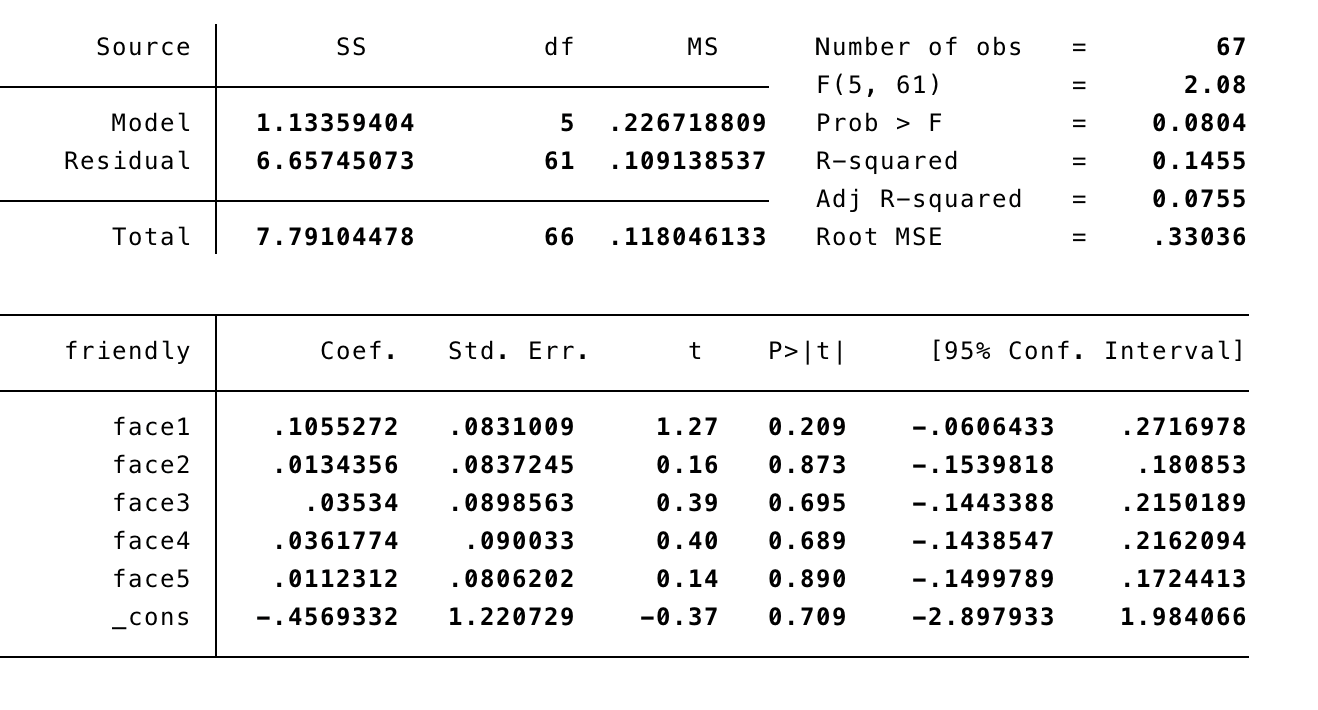

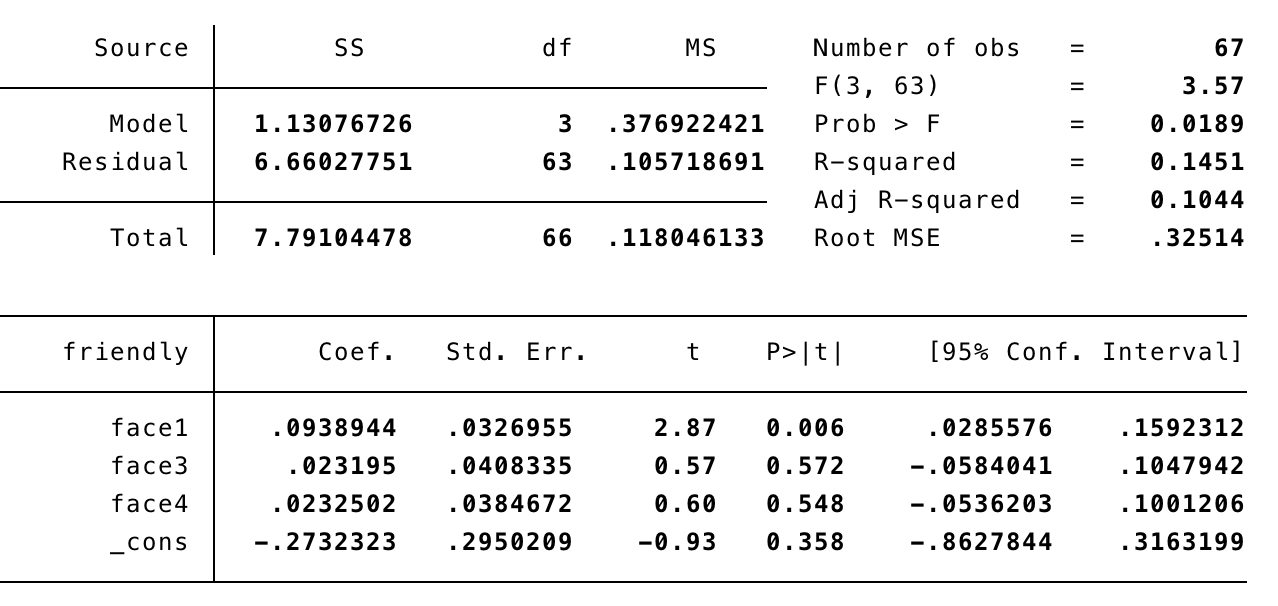
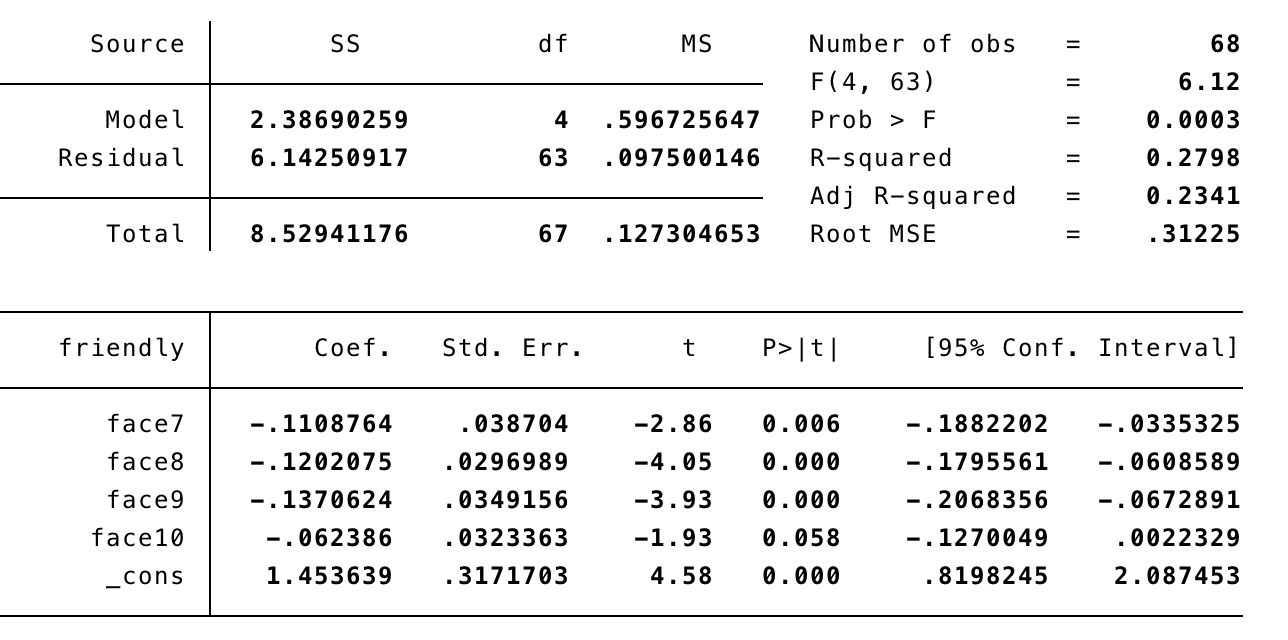
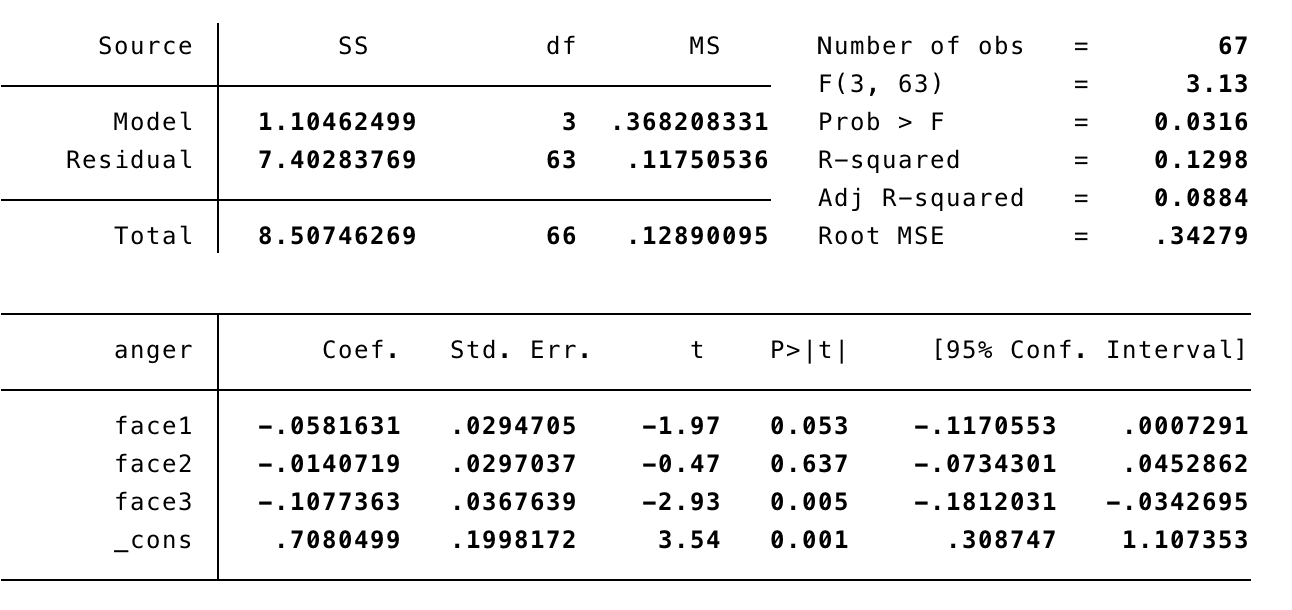
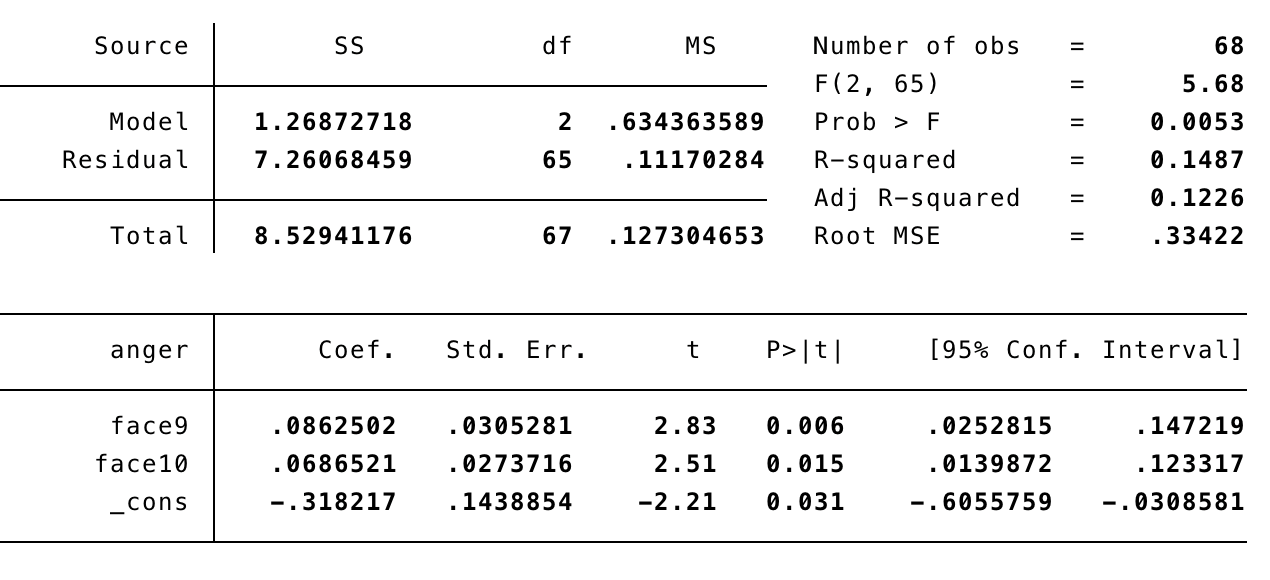
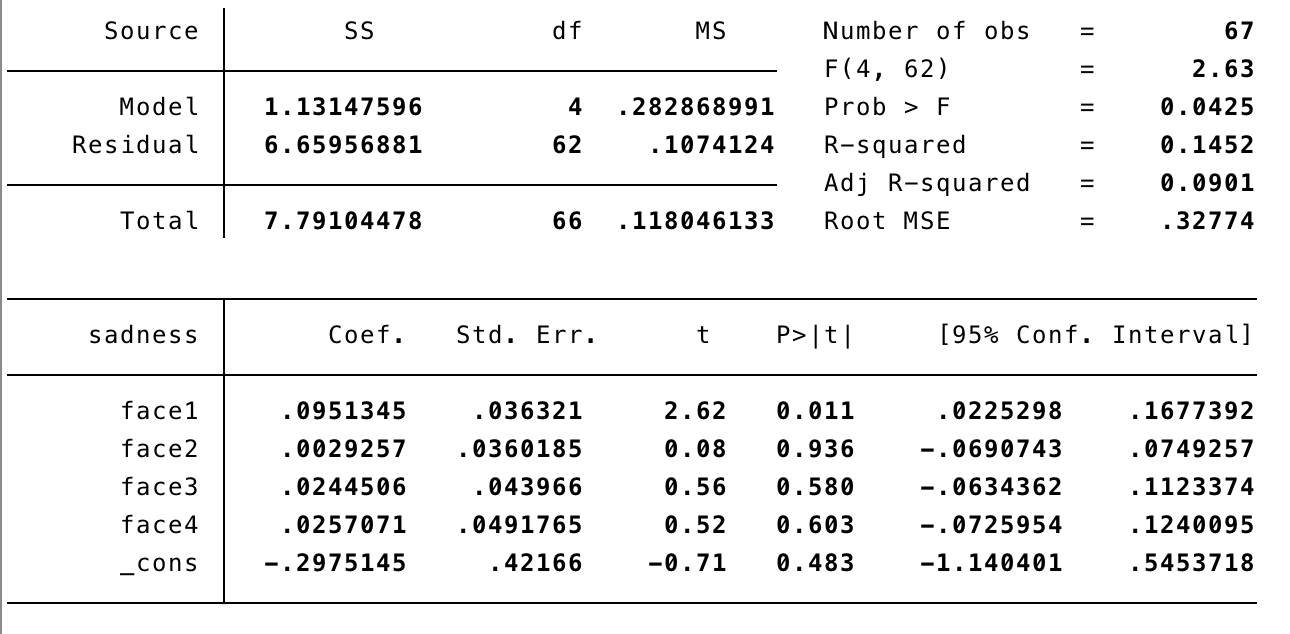
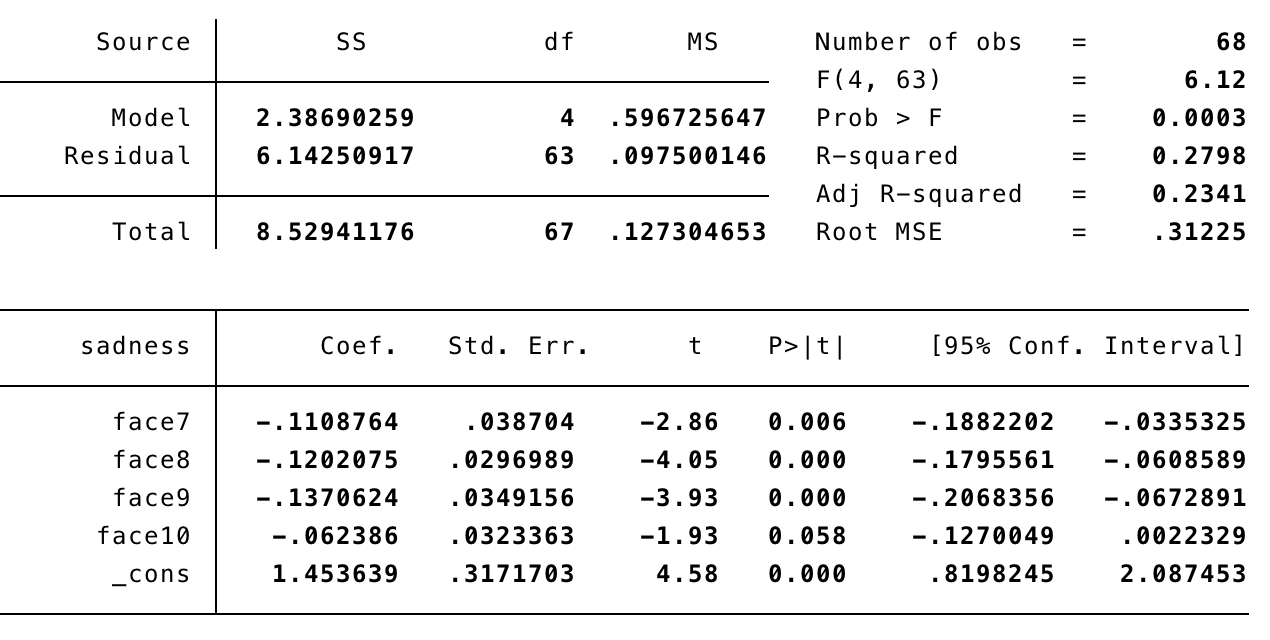
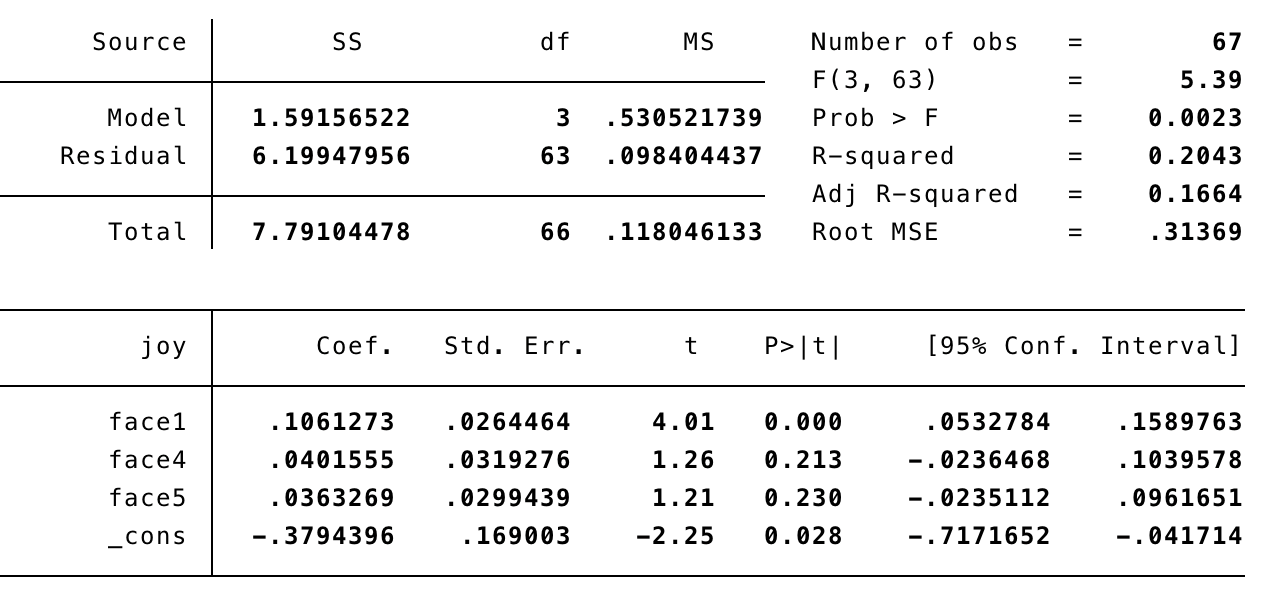
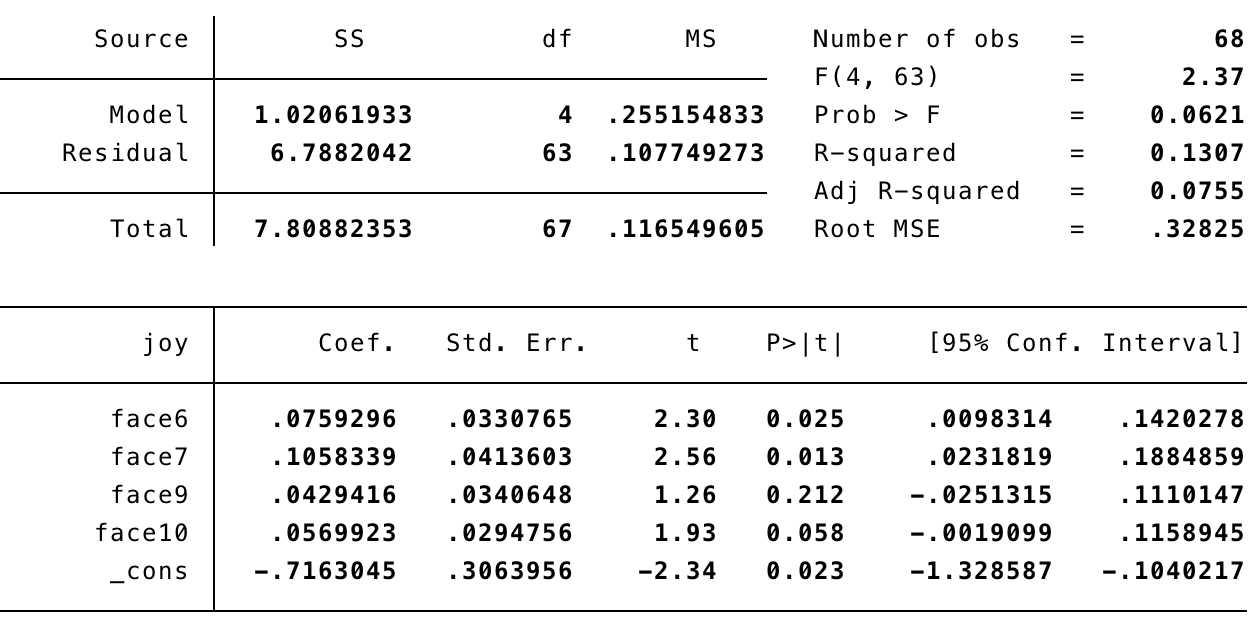
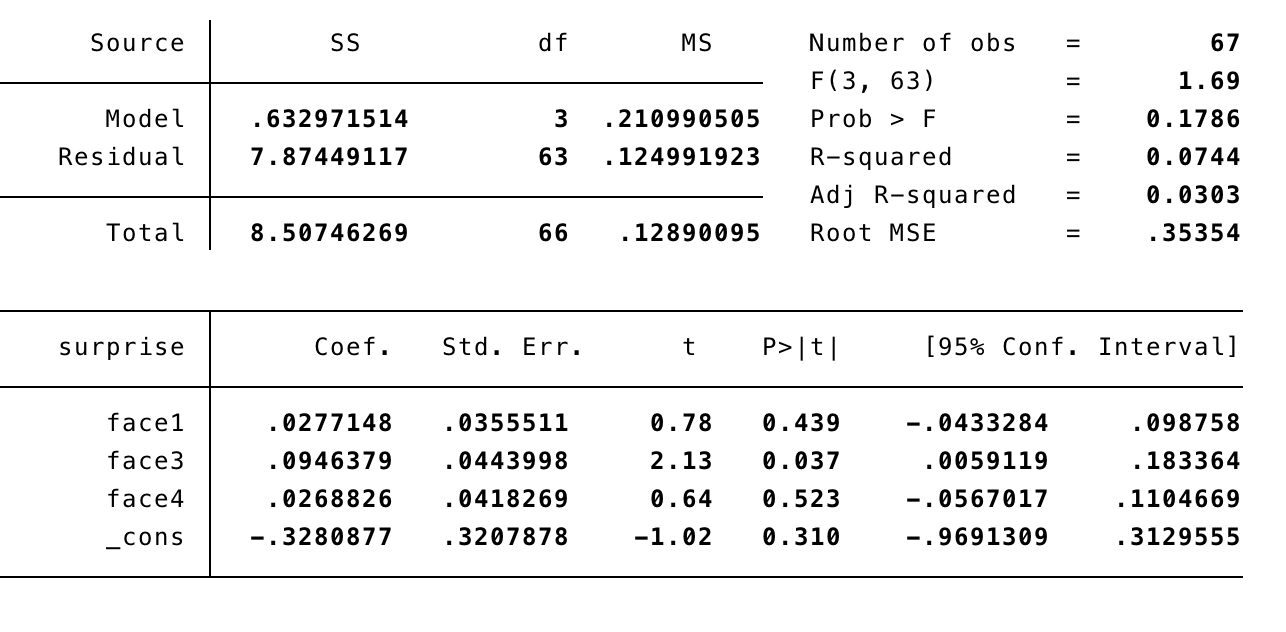



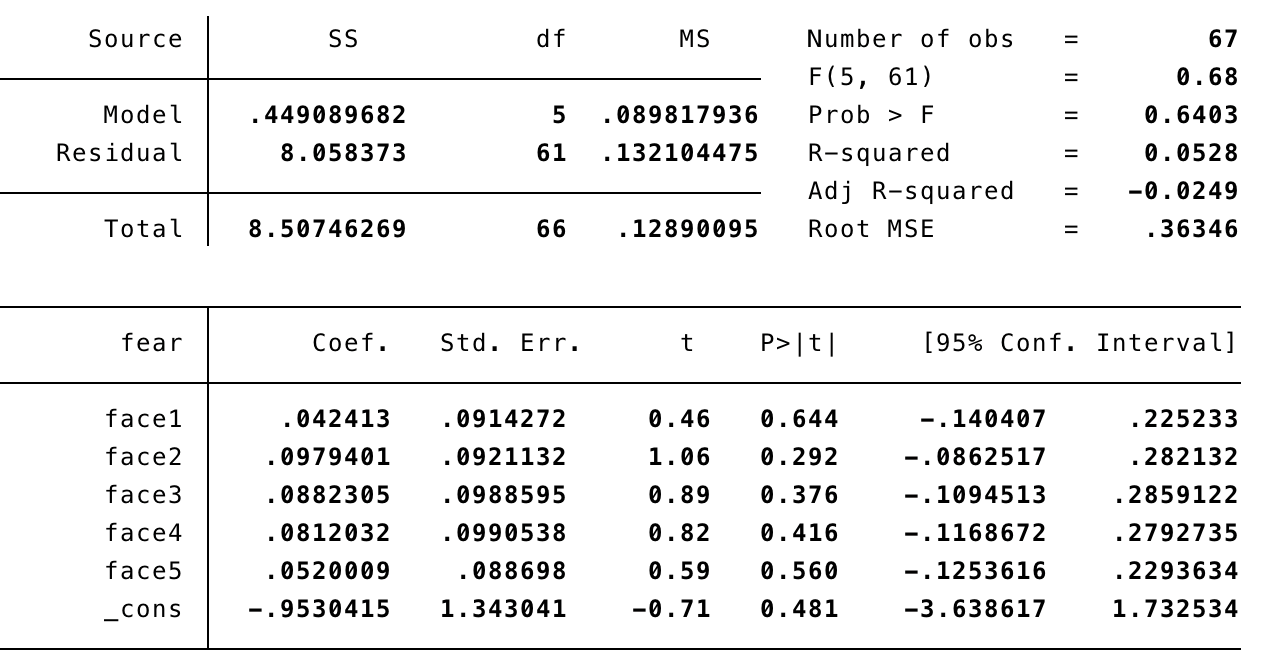

- The results of the regression on the emotion of friendliness are given in figure 5. Since none of the variables were significant in this model, we improved the model further, which can be found in figure 6.
- The results of the regression on the emotion of anger are given in figure 7. Since none of the variables were significant we improved the model further, hence faces 4 and 5 are missing.
- The results of the regression on the emotion of sadness are given in figure 8. Since none of the variables were significant, just as with the regressions of the previous models, therefore the model was improved.
- The results of the regression on the emotion of joy are given in figure 9, again with an improved model.
- The results of the regression on the emotion of surprise are given in figure 10, again with an improved model.
- The results of the regression on the emotion of dislike are given in figure 11, this model did not required any improvement.
- The results of the regression on the emotion of fear are given in figure 12.
Next the results of the regressions on the faces and emotions of test 2 are assessed:
- The results of the regression on the emotion of friendliness are given in figure 13. Even though faces 7, 8 and 9 were significant in this model, we tried to improve the model anyway, to see what happens.
- The results of the regression on the emotion of anger are given in figure 14. Since none of the variables were significant we improved the model further, hence faces 6, 7 and 8 are missing.
- The results of the regression on the emotion of anger are given in figure 15. We tried to improve the model further by removing face 6.
- The results of the regression on the emotion of joy are given in figure 16. Since no variables were significant, the model was improved by removing face 8.
- The results of the regression, after improvement, of the emotion of surprise are given in figure 17. Since no variables were significant, the model was improved by removing face 8.
- The results of the regression, after improvement, of the emotion of dislike are given in figure 18 . Since no variables were significant, the model was improved by removing face 8.
- The results of the regression, after improvement, of the emotion of fear is given in figure 19.
From these regression tables one can draw the following conclusions: For test 1:
- Face 1 (round eyes) was judged as expressing friendliness, sadness and joy;
- Face 3 (cubic eyes with sharp angles) was judged expressing the emotion of anger and surprise;
- For the emotion of dislike, all faces were significant;
- None of the faces were significant to the emotion of fear in this test, this yields that none of the faces were judged as expressing fear in particular by the elderly.
For test 2:
- The distribution of emotions to the faces was not quite as distinguishable as in test 1. Here, all faces express more than 1 emotion to be identified with, except for;
- Face 10 (rounded yellow eyes), which is only matched with anger;
- Face 6 (rounded blue eyes) expresses joy and surprise;
- Face 7 (rounded green eyes) expresses friendliness, sadness, joy and surprise;
- Face 8 (rounded red eyes) expresses, according to the elderly, friendliness, sadness, dislike and fear;
- Face 9 (rounded white eyes) expresses friendliness, anger, sadness and surprise. For surprise, face 9 was highly significant compared to the other faces.
Correlation
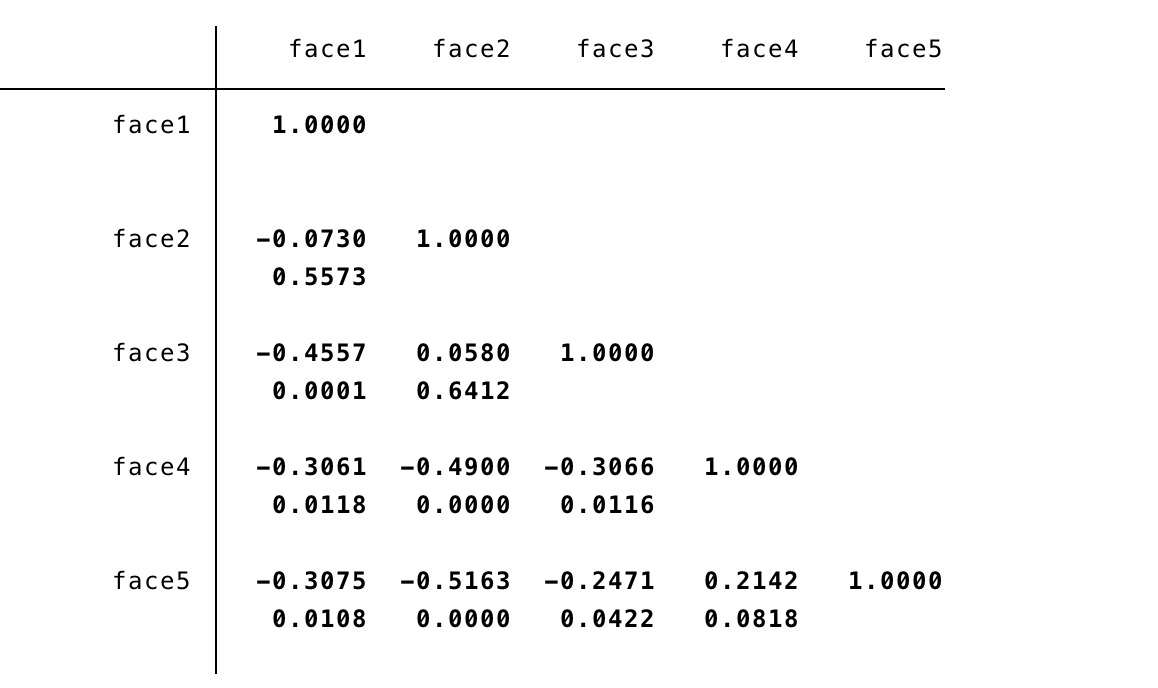

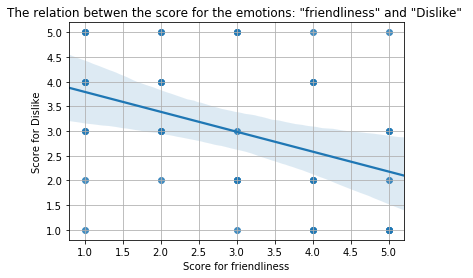
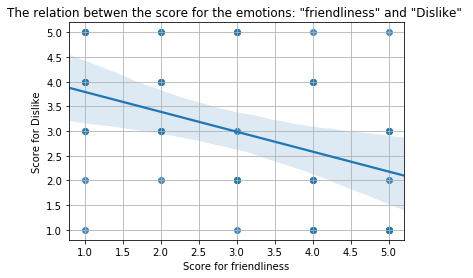
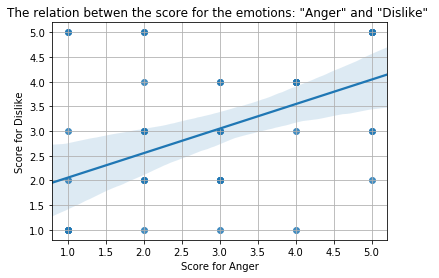
Figures 21 and 22 show a correlation tests for both test 1 and test 2. From these figures one can conclude that faces 1 and 3 are not likely to be assessed with the same score (thus are usually not ordered next to each other).
For the correlation between different emotions a regression is done as well, for the emotions which have the clearest correlation the regression plots are given in figure 23, 24 and 25 for the combination of emotions;
- From figure 23, one can derive that if an elderly assesses a face with a high score of the the emotion sadness this person will most likely asses the same face with a low score for the emotion of friendliness. So quite trivially, one can conclude that those emotions are each others opposites.
- From figure 24, one can clearly derive a relationship between the emotions friendliness and joy, that is, a face with a high score for the emotion of friendliness is most likely assessed with a high score for the emotion of joy as well.
- Idem dito for the emotions anger and dislike.
Conclusion
To summarize each statistical test, we will start with the normality. Normality was fine for each variable, except for two faces. Namely face 5 (triangle eyes with sharp edges) and face 8 (red rounded eyes). However, they both were pretty close to normality and both seemed fine to continue with, hence we did.
Next up is the regression tests. The first test performed on the elderly gave more distinctive results. Namely, face 1 (round eyes) came back as expressing friendliness, sadness and joy. Face 3 (cubic eyes with sharp angles) expresses anger and surprise. From the results one can conclude that none of the faces is (relatively) related to fear. The second test performed on the elderly gave for almost every face multiple emotions. Face 6 (rounded blue eyes) expresses joy and surprise. Face 7 (rounded green eyes) expresses friendliness, sadness, joy and surprise. Face 8 (rounded red eyes) expresses, according to the elderly, friendliness, sadness, dislike and fear. Face 9 (rounded white eyes) expresses friendliness, anger, sadness and surprise. Only face 10 (rounded yellow eyes) matched with one emotion, namely anger.
Finally a correlation test was performed. Here we learned that faces 1 (round eyes) and 3 (cubic eyes with sharp angles) are not likely to be assessed with the same score (thus are usually not competing for the same place on the ranking from 1 to 5). According to the tests, sadness and friendliness are each others opposites. The emotions of friendliness and joy are complementing each other, so do anger and dislike.
For the thematic analysis, the interviews were transcribed and coded. These codes were evaluated to create sub-themes and team. As such, 5 main themes were created: “User”, “Preferences”, “Context of use”, “Design” and “Functionality”.
The theme “User” includes codes that describe the personalities of the elderly and the way that they think about robots. The opinion of the elderly is important to design an interface that eventually will fit this type of user. There are 3 sub- themes within this theme: “Not open for the use of robot”, “Open for the use of robot” and “Personality of elderly”. They are described below:
• Not open for the use of robots Some elderly are not open for the use of robots. Most of the participants said that they did most of the chores themselves and that they did not need a robot that would help them with that. Other participants did not even had an experience with a robot and were convinced that they do not want a robot. Example: o Interviewer: “Dus u heeft er nooit een ervaring mee gehad?” Participant 001: “Nee, maar die hoef ik ook niet.”
• Open for the use of robots Some elderly are open for the use of robots and they said that they would trust a robot. Moreover, they would make use of the robot if it would be offered to them. Example: o Interviewer: “Had u het gevoel dat u die robots kon vertrouwen?” Participant 002: “Jawel, Jawel. Ja. Ja. Ja.” Interviewer: “Oke en waardoor dacht u dat?” Participant 002: “Omdat ze lief overkomen.”
• Personality of elderly Most of the participants told us that as long as they could, they wanted to do everything on their own. Almost all the participant said that independence is an important part of their lives. Some of the elderly were not that mobile anymore, however others were still participating in social and sport activities. Example: o ”Ik wil zo lang mogelijk zelfstandig blijven.” - Participant 001
“Preferences” aggregates the codes that relate to the preferences of the elderly when it comes to receiving care and helping in the household. Some people said that the caretakers would be more important if they would need more intensive care. Most of the people did not need that much care, so they did not mind if a human caretaker would be replaced by a robot. Others said that a robot in their house would be strange and scary and told us that also robots can make mistakes. The theme “preferences” has two subthemes: “human vs. robot” and “importance of caretaker”.
• Human vs. Robot
This subtheme describes if elderly would prefer a human or a robot to help them with the household. The opinions about this subject were divided. Some people would prefer a robot so they would not burden anyone with their care. Others would prefer a human.
Example:
o “Ik zou dan eerder voor een robot kiezen. Om een medemens te vragen om een
boodschap voor mij te doen dat gaat me moeilijk af denk ik. “ – Participant 105
• Importance of the caretaker This subtheme describes how important a caretaker is for the elderly. Some of the participants were used to one caretaker and had good connection with them. Other never used a caretaker or only used their help for some cleaning once a month. Example: o “Maar nu op het moment zijn ze vrij, ingrid. En dan krijg ik een andere hulp. En dat is toch wel een beetje vreemd. Je moet maar afwachten hoe of wat he.“ – Participant 002
“Context of use” describes the codes about the knowledge, experience and expectations of robots. When designing an interface, it is important to understand the users and their environment. It is important to know what people expect of robots and what they already know about them. With this information you can design to expectations, so nobody will be disappointed with the final product. This theme has two subthemes: “Knowledge & Experience” and “Expectation”.
• Knowledge & experience with robots
Most of the participants said that they did not have a lot of knowledge and experience with robots. If they did know something about the robots it was because of information via the television. A few participants were talking about the robot ‘Pepper’ and about hospital robots.
Example:
o Participant 102:“Ja ik zou niet weten wat ik daaraan zou willen veranderen of waar ik dat moet zien dat zou ik niet weten”.
Interviewer:” Waarom is dat? Denkt u dat u daarvoor niet genoeg weet van robots?”.
Participant 102:“ Ja ik weet er niet veel van, nee”.
• Expectation Because of the lack of knowledge and experience with robots, there were a lot of expectations towards robots. Some participants told us that a robot is something for in the future and that they would probably will not experience it because of their age. Others thought that robots could not go outside or that they would make a mess. Example: o Interviewer asked the participant why he/she does not need a robot. The participant answered: “Die maken veel te veel rommel op het appartement”.- Participant 001
“Design” describes codes that deal with the design of the robot. This includes how elderly think that a robot should behave, look and feel. Because of the lack of experience, these answers were mostly
based on their own fantasy or images that they saw on television. This theme has three subthemes: “Appearance of the robot”, “Material of the robot” and “Behavior of the robot”.
• Appearance of the robot
There were divided opinions about the appearance of a robot. Some participants told us that a robot should have a face that could reproduce emotions and that it should look humanoid. Other participants told us that they did not like a robot with a face, and that it should be a pure functional system without any human features. Some participants were very specific about the way that the face should look like.
Example:
o Interviewer: “En wat als u hem zich voorstelt. Wat voor soort gezicht zou hij moeten
hebben?”
Participant 101: “Een beetje vriendelijk gezicht. “
Interviewer: “Vriendelijk gezicht?”
Participant 101: “Jaa een beetje vriendelijk. Kennen ze met de ogen wel doen he.”
Interviewer: “U vindt vooral de ogen belangrijk?”
Participant 101: “Ja ja, de ogen toch?”
Interviewer: “Oke en waarom specifiek de ogen? Is dat omdat er voor u een betekenis achter zit?”
Participant 101: “Ja daaraan kun je het gezien een beetje zien met de ogen he ja.”
Interviewer: “Dat is omdat er gewoon veel emotie in zit?”
Participant 101: “Jaa, jaa”
• Material of the robot Most of the participants wanted the robot to feel soft. They did not like using wood, steel or metal, but preferred plastic or doll-material. There was one participant that thought it was important to think about a sustainable material. Example: o Interviewer: “Stel u moet de robot aan raken wat zou u willen dat u voelt?” Participant 102: “Ja gewoon plastic, dat het een beetje zacht aan voelt. Staal is zo koud he. Voelt koud aan. “
• Behavior of the robot Almost all the participants told us that it is important that a robot can show emotions. These emotions should be displayed clear and in a human way. We noticed that some elderly prioritize standards & values when it comes to interaction between people. Example: o Interviewer: “En moet hij een duidelijke emotie tonen ook?” Participant 003: “Ja tuurlijk. Hij moet hetzelfde doen als een mens want dat willen ze toch hebben. Interviewer: “Dus gewoon echt een volledige menselijke robot? Participant 003: “Ja.”
“Functionality” includes codes that describes what the elderly can already do themselves, where they need help and what they think that a robot could do for them. This information can be important when designing because you need to know the requirements of a system so it can bring value to the users. This theme includes 3 sub-themes: “tasks that are still doable for the elderly”. “Tasks that elderly get help with”, “Tasks that a robot could/should do according to the elderly”.
• Tasks that are still doable for the elderly
The participants wanted to do as much in the household as possible, without help from anyone. The participant was talking about small tasks like: doing dishes, washing clothes, making the bed, etc.
Example:
o “De rest dat doe ik allemaal zelf: wassen, strijken, koken. [onverstaanbaar]. Dan blijf je ook een beetje bezig. Als je zelf kookt moet je ook boodschappen doen en ook afwassen. Sjouwen, ik heb het net nog gedaan. Dan blijf je nog een beetje actief.” -
Participant ..
• Tasks that elderly get help with The participants told us that they get help with the big chores, like cleaning the bathroom and cleaning the kitchen. Example: “Met de..Een beetje met de badkamer. De grote dingen. Badkamer, wc’s. ik heb twee toiletten [onverstaanbaar] en ja de keuken [onverstaanbaar] daar wordt niet gekookt maar dat moet wel bijgehouden worden.” - Participant 003
• Tasks that a robot could/should do according to the elderly Most of the participants were not very keen to tell us what a robot could do for them. They emphasized the fact that they still do a lot by themselves and that they have a caretaker that can help them with big tasks. They only need help if they are not able to do it themselves anymore. Most of the elderly expect the robot to be able to do everything that you ask the robot. That it can give you attention, talk to you, pick up objects, cleaning a wall and help in the household. Example: o “Ja dan zou ik hem dingen laten doen waar ik zelf niet meer toe in staat zou zijn. Als er dan bijvoorbeeld iets van er moet gestofzuigd worden, dat kan ik niet meer, dan zou ik zeggen: nou doe jij dat effe.” – Participant ..
Discussion
Looking back at the test we designed and executed the majority went according to plan, but there were a couple things that should be improved for a future test.
First of all, the face design we used as a base for testing the connection of shapes and color to the emotion of a robot’s expression had a slight grin for all variations. At first we anticipated this would not cause an issue because it was the same for each face, but noticed that during the test there was at least one participant that did not want to rate the proposed variations on anger or sadness because it smiled. To solve this for a future test a more neutral mouth shape should be used.
Secondly, we had only ten participants to collect our data from that also were in the same caring facility. This means the test population of our experiment, together with our analysis and conclusion do not represent the target group on a real-world scale. To solve this, we would have to split up our group over different facilities while also making the test population larger to make the results more meaningful.
Thirdly, as we aimed to gather both quantitative and qualitative data, we asked participants to explain their reasoning behind the sorting of the faces in both tests. The problem we encountered was when the questions were asked, the answers were generally superficial and did not provide enough added value. As a result of this, the interviewers tended to veer off the interview guide to still collect the qualitative part of the data.
USE aspects
Users
Society
Enterprise
Conclusion
Discussion
References
Useful links
Netflix film 'Next gen' [30]
- ↑ https://www.oecd.org/newsroom/38528123.pdf OECD. (2007). Annual Report 2007. Paris: OECD Publishing.
- ↑ https://www.sciencedirect.com/science/article/pii/S0897189704000874 ANR. (2005). Applied Nursing Research 18 (2005) 22-28
- ↑ https://www.researchgate.net/publication/235328873_Dominance_and_valence_A_two-factor_model_for_emotion_in_HCI Dryer, Christopher. (1998). Dominance and valence: A two-factor model for emotion in HCI.
- ↑ https://www.ncbi.nlm.nih.gov/pubmed/23177981 Elaine Mordoch, Angela Osterreicher, Lorna Guse, Kerstin Roger, Genevieve Thompson (2013), Use of social commitment robots in the care of elderly people with dementia: A literature review, Maturitas, p 14-20
- ↑ http://www.cs.cmu.edu/~social/reading/breemen2004c.pdf
- ↑ https://ieeexplore.ieee.org/document/4058873 S. Sosnowski, A. Bittermann, K. Kuhnlenz and M. Buss (2006), Design and Evaluation of Emotion-Display EDDIE, 2006 IEEE/RSJ International Conference on Intelligent Robots and Systems, pp. 3113-3118.
- ↑ https://ieeexplore.ieee.org/document/4415108 D. Kwon et al. (2007), Emotion Interaction System for a Service Robot, RO-MAN 2007 - The 16th IEEE International Symposium on Robot and Human Interactive Communication, pp. 351-356.
- ↑ https://ieeexplore.ieee.org/document/5326184 M. Zecca et al. (2009), Whole body emotion expressions for KOBIAN humanoid robot — preliminary experiments with different Emotional patterns —, RO-MAN 2009 - The 18th IEEE International Symposium on Robot and Human Interactive Communication, pp. 381-386.
- ↑ https://affect.media.mit.edu/pdfs/99.picard-hci.pdf R. W. Picard (2003), Affective computing for HCI
- ↑ https://www.researchgate.net/publication/242107189_Emotion_in_Human-Computer_Interaction Brave, Scott & Nass, Clifford. (2002). Emotion in Human–Computer Interaction. The Human-Computer Interaction Handbook: Fundamentals, Evolving Technologies and Emerging Applications. 10.1201/b10368-6.
- ↑ https://www.ncbi.nlm.nih.gov/pubmed/2029364 Levenson, R. W., Carstensen, L. L., Friesen, W. V., & Ekman, P. (1991). Emotion, physiology, and expression in old age. Psychology and Aging, 6(1), 28-35.
- ↑ https://www.tandfonline.com/doi/abs/10.1080/00207450490270901 Susan Sullivan & Ted Ruffman (2004) Emotion recognition deficits in the elderly, International Journal of Neuroscience, 403-432.
- ↑ https://ieeexplore.ieee.org/document/911197 R. Cowie et al., "Emotion recognition in human-computer interaction," in IEEE Signal Processing Magazine, 32-80, Jan 2001.
- ↑ https://www.researchgate.net/publication/3450481_Living_With_Seal_Robots_-_Its_Sociopsychological_and_Physiological_Influences_on_the_Elderly_at_a_Care_House Wada, K & Shibata, Takanori. (2007). Living With Seal Robots - Its Sociopsychological and Physiological Influences on the Elderly at a Care House. Robotics, 972-980.
- ↑ https://www.researchgate.net/publication/229058790_Assistive_social_robots_in_elderly_care_A_review Broekens, Joost & Heerink, Marcel & Rosendal, Henk. (2009). Assistive social robots in elderly care: A review. Gerontechnology, 94-103.
- ↑ https://www.researchgate.net/publication/226452328_Granny_and_the_robots_Ethical_issues_in_robot_care_for_the_elderly Sharkey, Amanda & Sharkey, Noel. (2010). Granny and the robots: Ethical issues in robot care for the elderly. Ethics and Information Technology. 27-40.
- ↑ https://ieeexplore.ieee.org/document/5751987 A. Sharkey and N. Sharkey, "Children, the Elderly, and Interactive Robots," in IEEE Robotics & Automation Magazine, vol. 18, no. 1, pp. 32-38, March 2011. doi: 10.1109/MRA.2010.940151
- ↑ https://www.ncbi.nlm.nih.gov/pubmed/11742772 FG. Miskelly, Assistive technology in elderly care. Department of Medicine for the Elderly
- ↑ https://alzres.biomedcentral.com/articles/10.1186/alzrt143 M. Wortmann, Alzheimer's Research & Therapy (2012)
- ↑ https://academic.oup.com/biomedgerontology/article/59/1/M83/533605 The Journals of Gerontology: Series A, Volume 59, Issue 1, 1 January 2004, Pages M83–M85
- ↑ https://dl.acm.org/citation.cfm?id=1358952&dl=ACM&coll=DL N. Sadat Shami, Jeffrey T. Hancock, Christian Peter, Michael Muller, and Regan Mandryk. 2008. Measuring affect in hci: going beyond the individual. In CHI '08 Extended Abstracts on Human Factors in Computing Systems (CHI EA '08). ACM, New York, NY, USA, 3901-3904. DOI: https://doi.org/10.1145/1358628.1358952
- ↑ https://ieeexplore.ieee.org/document/1642261 H. Shibata, M. Kanoh, S. Kato and H. Itoh, "A system for converting robot 'emotion' into facial expressions," Proceedings 2006 IEEE International Conference on Robotics and Automation, 2006. ICRA 2006., Orlando, FL, 2006, pp. 3660-3665. doi: 10.1109/ROBOT.2006.1642261
- ↑ https://ieeexplore.ieee.org/document/4755969 M. Zecca, N. Endo, S. Momoki, Kazuko Itoh and Atsuo Takanishi, "Design of the humanoid robot KOBIAN - preliminary analysis of facial and whole body emotion expression capabilities-," Humanoids 2008 - 8th IEEE-RAS International Conference on Humanoid Robots, Daejeon, 2008, pp. 487-492. doi: 10.1109/ICHR.2008.4755969
- ↑ https://www.researchgate.net/publication/235328873_Dominance_and_valence_A_two-factor_model_for_emotion_in_HCI Dryer, Christopher. (1998). Dominance and valence: A two-factor model for emotion in HCI.
- ↑ https://www.ncbi.nlm.nih.gov/pubmed/15812732 AM. Williams et al., 'Enhancing the therapeutic potential of hospital environments by increasing the personal control and emotional comfort of hospitalized patients.' (2005)
- ↑ https://www.ncbi.nlm.nih.gov/pubmed/15936178 A. Tessitore et al., 'Functional changes in the activity of brain regions underlying emotion processing in the elderly.' (2005)
- ↑ https://academic.oup.com/ppar/article-abstract/17/4/12/1456824?redirectedFrom=fulltext Adele M. Hayutin; Graying of the Global Population, Public Policy & Aging Report, Volume 17, Issue 4, 1 September 2007, Pages 12–17
- ↑ https://www.who.int/hrh/com-heeg/reports/en/ World Health Organisation, 'Working for health and growth: investing in the health workforce' (2016)
- ↑ https://www.researchgate.net/publication/323590718_Characterizing_the_Design_Space_of_Rendered_Robot_Faces Kalegina, Alisa & Schroeder, Grace & Allchin, Aidan & Berlin, Keara & Cakmak, Maya. (2018). Characterizing the Design Space of Rendered Robot Faces. 96-104. 10.1145/3171221.3171286
- ↑ https://www.youtube.com/watch?v=uf3ALGKgpGU netflix film trailer 'Next gen'